We’ve hosted thousands of events for our clients and understand how challenging event planning can be. From the get-go, an event planner needs to juggle a million tasks, wear many hats, and stay organized. At every step of event planning, the most important objective is to stay on course to achieve all the event goals that you set out in the first place.
Whether you’re hosting a virtual, in-person, or hybrid event, this guide will be the perfect starting point. We have developed this guide to help you plan your event from day one to the curtain call.
Chapter 1: What is Event Planning?
Event planning underlines every task or activity that an event organizer needs to do before they are ready to host an epic event. It means the entire process of setting up an event and managing all of its aspects. This includes setting up a date, an agenda, finding speakers, marketing the event to a wider audience, and so much more.
Event planning business can be a humongous task if you don’t know where to start. To make your event planning steps easier, you need to invest in some right tools and work with the right team. Whether you’re hosting a job fair, tradeshow, or conference, you will have to lay out an event plan and then structure your event planning efforts accordingly.
Event Management VS Event Planning
Event Management and Event Planning, while closely related, involve distinct aspects of orchestrating an event. Event Planning primarily focuses on the design and logistics leading up to the event. This includes tasks like selecting themes, choosing venues, arranging catering, and coordinating entertainment. It’s about setting the stage for the event, meticulously organizing every detail to ensure the event’s concept comes to life.
Event Management, on the other hand, deals with the execution and operation of the event itself. It involves overseeing the event’s smooth running, handling any issues that arise during the event, and ensuring that all elements of the event plan are implemented effectively. While planning is about creating the blueprint, management is about bringing that blueprint to life and handling the real-time dynamics of the event.
Key Differences Between Event Planning VS Event Management At a Glance:
Event Planning:
- Focuses on the design and logistics before the event.
- Involves selecting themes and choosing venues.
- Arranges catering and coordinates entertainment.
- Organizes every detail to bring the event’s concept to life.
Event Management:
- Deals with the execution and operation during the event.
- Involves overseeing the event’s smooth running.
- Handles issues that arise during the event.
- Ensures effective implementation of the event plan.
- Manages the real-time dynamics of the event.
What Is an Event Plan?
If you’re just starting out on event management and event planning, the first thing you need to do is to develop an event plan. An event plan is where you hash out all the details before you begin working on the ground.
There can be a few different steps to event planning and developing a detailed plan can help you navigate more easily. Start off by making a list of all the things that you think you need to do. Even the minutest of these tasks should be on your list. Then, make a chart with the three stages of your event planning:
- Pre-event planning
- Things to do during event days
- Post-event plans
It will now be easier to start putting your humongous list of tasks into the right stage of your event planning process. This basic event plan can break all tasks down so you can focus on one task or one stage at a time and still get everything done in an organized manner.

What Should You Add to an Event Plan?
An event plan needs to be detailed enough so you don’t miss anything. But it also needs to be easy and quick to follow for everyone involved. If you’re confused about what should or shouldn’t be a part of your event plan, here is a basic list that you can start off with:
- Start your event planning business by adding your main aim behind the event. This is the most important piece of information that you always need to remember.
- Mention the names or contact information of all the people involved in making your event come to life. This can include vendors, company reps, staff members, sponsors, etc.
- Next, jot down general information about your event like the date, venue, timeline, etc.
- Make it easier for your staff by making a list of all the roles and responsibilities that you have assigned to people. Whether you’re hosting an in-person, hybrid, or virtual event you should make sure that none of your staff is overworked.
- Marketing and PR are vital components of event planning. So, make sure you add a PR and marketing plan to your event plan as well.
- Budget and insurance can define a lot about the scope of your event. The more budget or insurance coverage you have, the bigger your event can be. Therefore, your event plan needs to have a budget plan and details of insurance.
What Are the 5 Basic Principles of Event Planning?
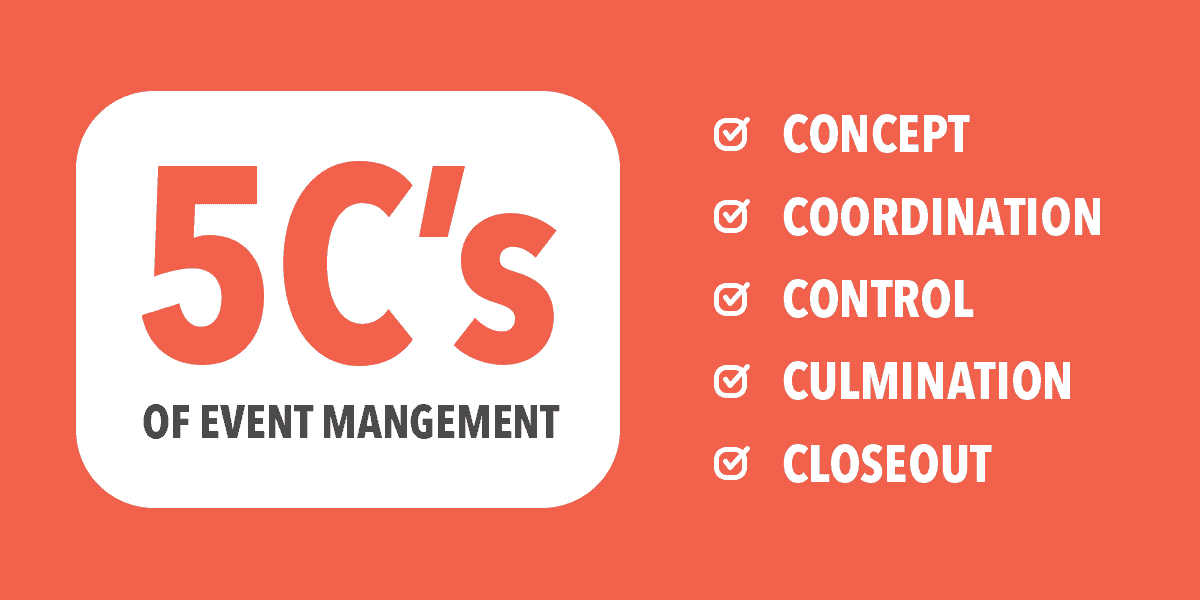
Event organizers need a few essential skills to be able to pull off a successful event. Whether you’re hosting a seminar, a conference, or a trade show, you need to follow the 5 C’s of event management: concept, coordination, control, culmination, and closeout.
These five C’s are the key elements that make up the recipe for smooth event planning and an epic event. If you have these down, you have a great chance at hosting a successful and memorable event.
Concept
The first and most important step to running a successful event planning process is to develop the concept or theme behind it. This means developing an objective before you take the next step. Think about why you want to host this event and what you can get out of it.
Coordination
The second step is where the on-ground event planning begins. Coordination means managing the logistics and building the project from the ground up. This step can involve all the physical aspects like selecting and setting up a venue, itinerary, entertainment, speaker sessions, etc.
Control
The third step involves understanding and controlling all the different aspects of the event through a bird’s eye view. So, this step is something that event organizers will be doing throughout the event planning process. It can include things like managing the staff and their responsibilities, controlling the budget, allocating resources, time management, etc.
Culmination
The culmination is everything that you need to do on the event day. The day of the event can be overwhelming, and if you don’t have a plan it can be total chaos. This is the day that your team has been working so hard for and there’s a lot riding on it. This step of event planning is where communication is the key as it involves handling all the logistics and setting up contingency plans in case anything goes wrong.
Closeout
The final stages of the event are usually post-event activities. In the closeout stages, event organizers can clear outstanding vendor payments, collect event data, and ask for attendees’ feedback. This stage is about closing up shop and calculating how successful your entire event planning process was. This is the ideal time to nurture the connections you’ve made to improve business or keep attendees engaged enough for future events. In the closeout stages, you can reach out to contacts, repurpose event content and distribute it through other mediums, keep attendees interested through social media community building, etc.
Chapter 2: How to Plan an Event
Developing a step-by-step plan at the very beginning of your event planning journey can help you sort out everything from the get-go. An event checklist can help you focus on one step at a time so you don’t get lost trying to finish the extended tasks.
Read on to find all the steps you should add to your event plan and get your hands on a fantastic event planner that makes things easier.
10 Steps for Planning an Event
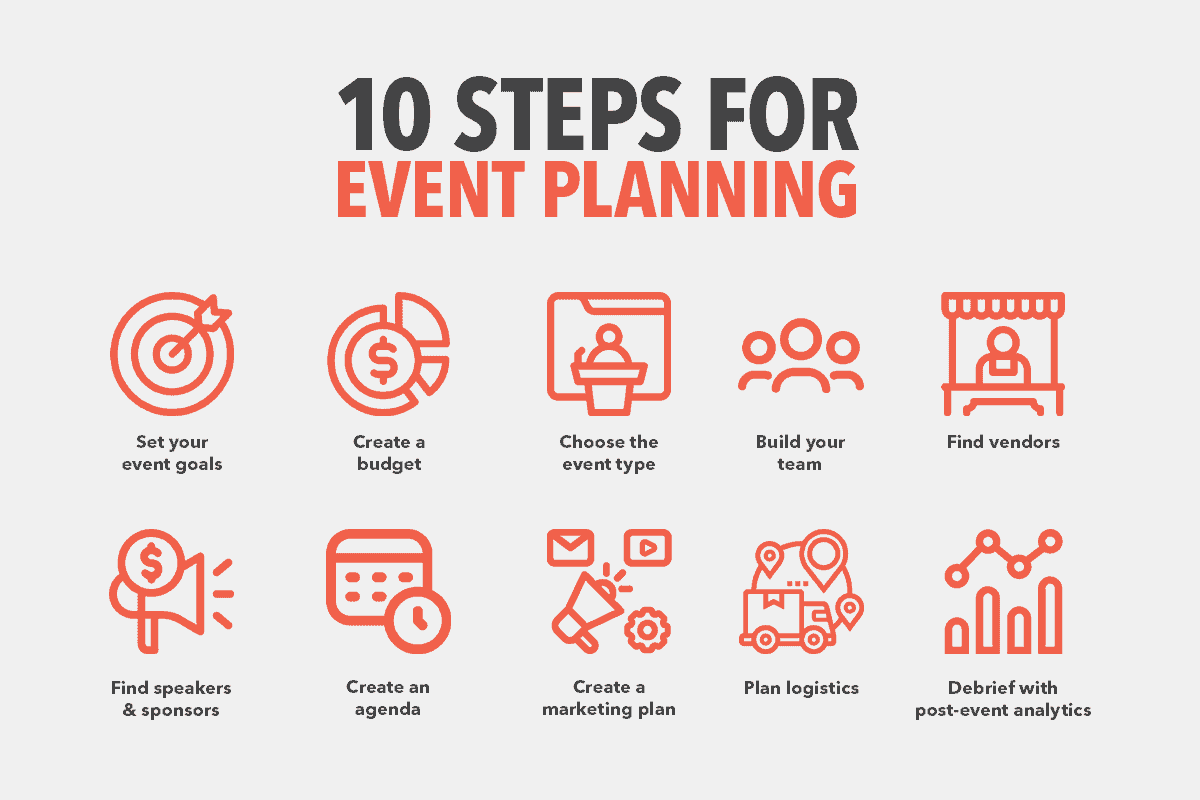
Starting out, narrowing your event planning steps down to just ten sounds impossible. However, all you need to do is think about the bigger picture and what absolutely needs to be done. Then, you can break these steps down to further individual tasks.
This guide can help you narrow down the ten most basic steps of your event planning process. Let’s start:
1. Set Your Event Goals
Defining the scope of your event can be one of the first main challenges to take on during event planning. If your event goals aren’t clear enough, you can’t plan something great to achieve those goals either. So first and foremost, decide what you want to achieve through your event and then work towards it.
Almost all events have a main goal and they’re then designed in a way to support that aim. Some common examples of event goals can be:
- Launching a new product
- Hiring new resources
- Maximizing attendance
- Educating your audience about a particular industry trend
- Selling a service or a product
- Capturing potential qualified leads
- Fostering a deeper connection with existing clients
- Networking and building a relationship with your peers
- Increasing brand visibility and awareness.
- Providing a platform for personal and professional growth
2. Create an Event Budget
The next step in event planning, after you have a goal, is to set up event budgeting. If you don’t know how much money you’re allowing yourself to spend on each step of the event planning process, you will more than likely spend excessive amounts. Budgeting is important to set a line for yourself and your staff so you can get the most out of the money spent.
Some of the things that you need to do when setting an event budget are:
- Categorize all your expenses into most and least important so you can make better decisions if money is tight.
- Research vendors and estimate costs before you start.
- Consider hidden costs, any possible surcharges, or other miscellaneous costs.
- Define all your income sources from the event to calculate better ROI.
- Stay as realistic as possible and use the upper limits for all the estimates that you’re putting in on your budgeting sheet.
The scope and size of your event depend greatly on your event budget. Event budgeting allows you to create a master plan so you can achieve the most with what you have. For example, it can be easier to decide the delivery model of your event, the marketing spend, the number of people you can invite or hire, and more.
3. Choose the Event Type or Delivery Model
Once you have a main event goal and have also set a budget, there will be some level of clarity in what you want to achieve. So, now is the best time to choose how you want to host this event. There are three main event types to choose from:
Virtual events are completely online and have been used as an accessible and convenient way of hosting events for organizations all around the world. Online events are much less expensive compared to traditional in-person events. Moreover, they also reduce carbon footprint, create global access, and reduce many logistical issues.
In-person events are the traditional way of hosting events where attendees have to commute to a physical location to be a part of the event. These events cost more money but offer a much more personal and engaging experience. Moreover, the latest in-person event technology can offer streamlined attendee experiences such as quick check-in and badge printing processes, and onsite networking and engagement.
Hybrid events are the best of both worlds. They combine both in-person and virtual events and offer an experience unlike any other. Some parts of the event can occur online, while some parts can be in-person. This way, global attendees can still get access to the event’s sessions and content while opening up networking opportunities for in-person attendees as well.
4. Build Your Team
Now, you can start creating your dream team for the next steps of event planning. The organizing committee can have a bunch of different members, technical staff, marketers, and even volunteers. The whole team has to work together to build a successful event.
If your team doesn’t gel well, the event planning process can become equally more difficult for you. So, make sure you pick the best people who have a passion for events. The most resourceful people will work with you to build the event of your dreams.
Once you have a team, you will also need to define their roles and responsibilities. This is crucial so that no one steps on another person’s toes and everything runs smoothly. Moreover, this is also your chance to delegate the work efficiently so no one is overworked.
5. Find & Vet Vendors
Whether you’re hosting an in-person, hybrid, or virtual event, you will need a list of different vendors for various event activities. For a virtual event, you need to find event registration and ticketing software, event management software, and a hosting platform. You might also need to find marketing tools and vet all these vendors.
In-person and hybrid events need the most effort at this stage of event planning because the physical nature of the event demands more services on live days. For example, you will need a catering service, a security company, A/V vendors, etc.
The vetting process for vendors for any event is crucial to make sure that you pick the right ones. Here are some important tips that you should consider:
- Compare the rates of a few different vendors and collect their portfolios at the very beginning of your search. Then choose the best ones based on their services and charges.
- Read online reviews of all the vendors that you have shortlisted and make an informed decision.
- Keep customer service as a top priority when choosing a service provider.
- A particular vendor might be offering a bunch of services, however, that doesn’t mean they will be the best at all of them. Make sure you pick vendors that are experts for the service that you’re hiring them for.
- Ask all vendors for their registrations and licenses before you sign a contract with them.
- Read and re-read the contract multiple times before signing to make sure all the i’s are dotted and the t’s are crossed.
- If you’re sourcing a vendor through a referral, make sure you do your due diligence.
6. Find Speakers and Sponsors
One of the most important steps of event planning is to find speakers and sponsors for your event.
Sponsorships are one of the best ways to generate revenue at any event. You can offer sponsors freebies, host a live session with them, or even offer them space for placing logos and branding. This event planning guide will delve deeper into how to find sponsors and how to monetize your event later.
Speakers can be one of the biggest highlights of the event. Attendees often come to events to listen to an expert speaker or a celebrity keynote. So, finding the right speakers for your event can be crucial for adding more value to your event, boosting attendance, and increasing event engagement.
7. Create an Event Agenda
Now is the time to start planning the activities for your event and building the agenda. From the first day of the event to the last, your attendees are looking forward to gaining value for their time. So, make sure you have something in store for your audience and aren’t wasting their time.
An agenda can be helpful in creating a good flow for your event and add in a mix of learning, engaging, and fun activities. Here’s how you can create an event agenda for your next event:
- Figure out the duration of your event. It can be anywhere from a few hours to a few days. This will provide a basic framework for your event agenda.
- Develop a list of all the most important activities you would like to add to your event. For example, a welcome note, a keynote session, expert panel discussions, breakout rooms, games, lunch breaks, etc.
- Now, allocate time for each activity so that you can divide up the day of the event accordingly.
- Depending on the significance of the activity or session, allocate the prime time spot to them. For example, keynote speaker sessions happen during midday or at the end of each day to get the most traction.
- Make sure you’re adding ample breaks in the middle of sessions to give your attendees a much-needed breather. You can separate important sessions with a lunch break or a fun group activity to rejuvenate the audience.
- Add some breaks in the middle of sessions to make up for delays or sessions running over.
TIP: Set some time to review the agenda one last time to adjust any last-minute changes to the event. You should share the agenda with all the sponsors, exhibitors, speakers, or any other stakeholders at your event well in advance so any discrepancies can be dealt with in time.
8. Create a Marketing Plan
Imagine that you have designed one of the most amazing events with tons of great speaker sessions and informative content. But, you aren’t getting any registrations. No need to fret because a well-developed event marketing plan can fix that for you.
Event marketing is a humongous task in itself, but without it, your event won’t get the attention it deserves. There are a few different ways to market your event, and here are some of the mediums that you can use:
- Email marketing campaigns
- Social media channels like LinkedIn, YouTube, Facebook, etc.
- Event website
- Paid ads on social media and Google
- Influencer marketing
- Content marketing
- SEO
9. Plan Logistics for Live Days
All your efforts boil down to the live event days. This is the most crucial time of the event planning process, and one misstep here can ruin everything you have worked so hard to achieve for months.
So, logistical planning and setting up contingency plans for the main event days are absolutely crucial. You should be prepared for the worst and have a plan B and C in place too. You can’t expect everything to go smoothly but if you’re prepared for it you won’t get blindsided.
For In-Person Events
In-person and hybrid events have a physical venue and involve attendees arriving from different areas to one destination. So, the logistics and planning of the event are most important.
Plan how your speakers and attendees are arriving. This includes arranging transportation, accommodation, and parking spaces.
You also need to collaborate with vendors and suppliers to make sure they’re at the venue on time, and make sure that the catering is all set.
Double-check all A/V equipment so there are no surprises during live sessions. Following the event schedule should also be a top priority because time management is a big part of running a successful event.
You should develop a floor plan so all exhibitors know where they’re supposed to go, especially if the venue is fairly large.
For Virtual & Hybrid Events
Virtual events might not be as daunting as far as live days are concerned. However, there are still some important things that you should do to streamline the event.
Since virtual events are hosted through an online platform, most of the logistical checks you need to do will be technical tests. So, go around the whole platform once and make sure all the links are working, run test sessions for webinars with your guest speakers, and remove any possible bugs.
To make it an even smoother experience for exhibitors and attendees, you can run training sessions with them in advance. This can be helpful to transition them into the virtual environment especially if they aren’t tech-savvy.
10. Debrief with Post-Event Analytics
Event planning is primarily over once the event is finished, however, that’s not the last step for event coordinators who want to make the most of it. This is the best time to debrief your entire team by collecting and analyzing event data.
Most hybrid and virtual event providers will offer an in-depth event analytics dashboard. These can have event data such as the number of users who logged in, booth visits, webinar views, link clicks, etc. Moreover, you can also collect more data by running post-event audience polls.
All this data, if analyzed properly, can offer fantastic and actionable insights for event organizers. It is always best practice to consider audience feedback to further improve event experiences for them.
Bonus: Event Planning Template
Developing an event plan is the most crucial first step for hosting an epic event. Even if you know all that you need to know, creating an actual plan for event planning can take time and effort. Even then, you may miss out on something crucial that could’ve made your event even better.
Use our event planner template to get a head start on your event planning and execution.
Chapter 3: How to Set Up Your Event
Event setup is one of the most crucial parts of your event planning journey. This is where things start to shape up whether you’re an in-person, hybrid, or virtual event. Setting up the event website, figuring out the venue, finding the right vendors, and building a social media presence might be the first few steps you need to take at this point.
We will talk about virtual, hybrid, and in-person event setup processes in a bit. However, here are a few things you need to do no matter what your event delivery model is.
1. Create an Event Website
Event setup and creation should start with creating an event website where attendees can come to get the latest updates, event information, or other details. You can also create a page for showcasing your event agenda and collecting registrations.
The event website should focus on creating the right image of your event for your attendees and should match your event’s vibe. So, make sure you pick the right template, use your brand’s logos and colors, and customize the website to create an eye-catching design.
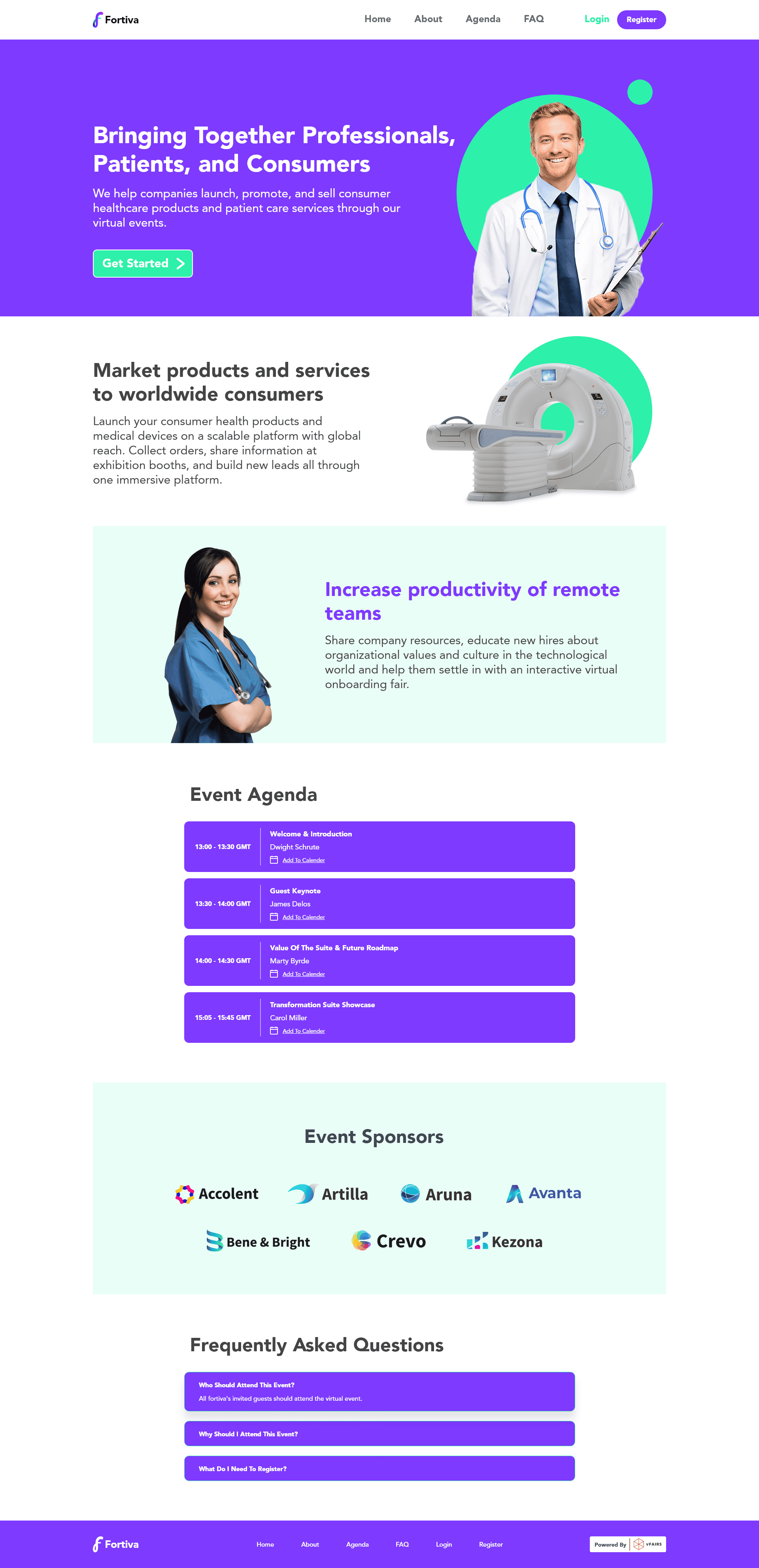
2. Build Social Media Channels
The next thing you need to do is start creating an event page. You can use LinkedIn, Facebook, Twitter, Instagram, or other social media channels to promote your event. Social media channels can be a great way for event promotion as well as creating meaningful connections with your audience.
Building these social media channels can lay the foundation for building a community around your event as well. You can integrate tools like the vFairs LinkedIn community builder and boost attendee engagement. Moreover, you can also run paid ads through these social media outlets once you’re in the marketing stages of your event plan.
3. Create a Ticketing & Registration Process
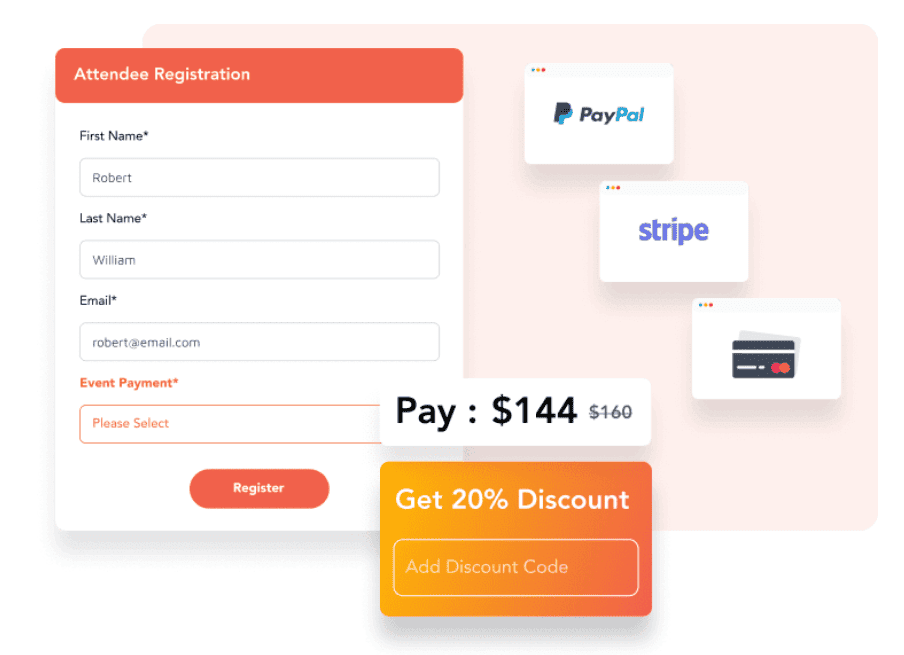
Next, you will need to set up a ticketing system for your event. Whether your event is free to attend or has a priced ticket, an event ticketing and registration system can allow you to set up a registration page, ticket pricing tiers, print tickets, or check-in attendees at an event.
One of the first things you’ll need to do is to set up a registration form. An effective registration form will help you get the right information from attendees and then use the data to create an impressive event experience for them. Registration forms for physical ticketing can also include pictures or meal preferences.
Setting Up a Virtual Event
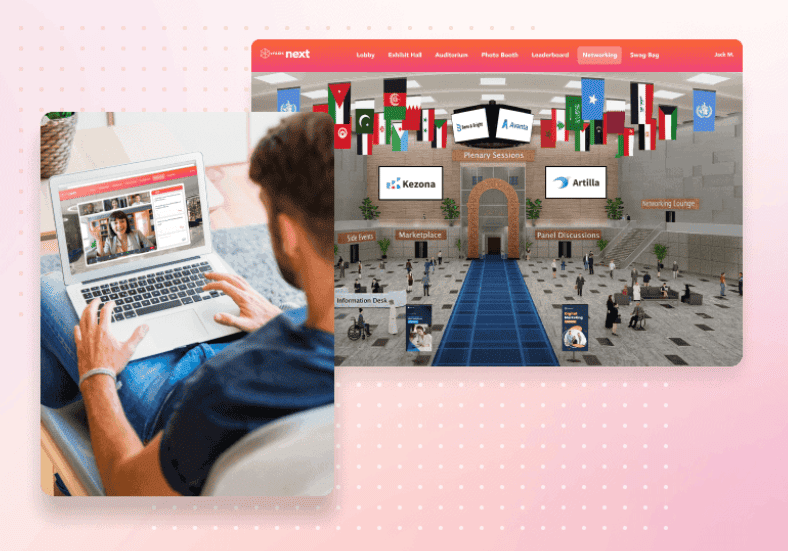
Now, let’s talk about setting up your virtual event because there are certain things you will need to do differently. First, you need to choose a virtual event platform to host your event (more on this later in this guide). Then, you can start setting up your event for your attendees.
As the event is completely online, you should think about the complete journey that your attendees will take once they register. This includes logging in, entering the virtual environment, watching the webinars, visiting virtual booths, etc.
Planning and executing a virtual event can be a hands-on experience for many event organizers and this virtual event planner can help you weather the storm and design an epic event.
Virtual Event Features to Consider
You can choose a number of features for your virtual event to add value for attendees, speakers, and exhibitors. You can add an external or internal lobby, an auditorium for sessions, networking features like chat, spatial networking, roundtables, virtual exhibit halls, etc.
Choosing which virtual event features to add to your event depends upon your event type and goals. For instance, a virtual trade show event needs to have an exhibit hall and maybe some e-commerce features and a virtual conference should have an immersive webinar experience, etc. Some of the top features to consider include:
- Virtual environment (lobby, exhibit hall, auditorium, etc.)
- Webinars or virtual auditoriums
- Networking features (chat, roundtables, spatial networking, etc.)
- Integrations with marketing tools, CRMs, ATS, etc.
- Event gamification tools
- Accessibility features
- Live and post-event analytics
- Polls and Surveys
- Job board (for hiring events)
- Shopping cart (for trade shows)
- Abstract management features (for conferences)
Setting Up an In-Person Event
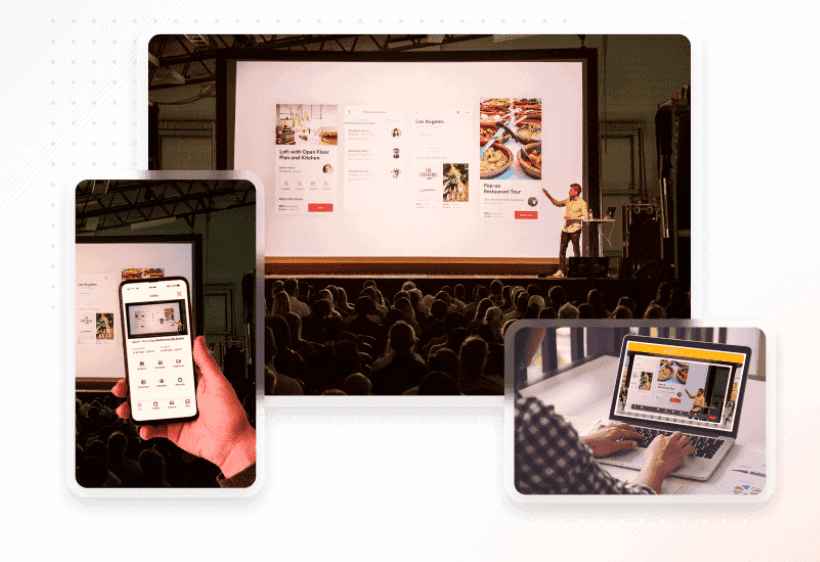
Now let’s move on to the things you will need to do to set up an in-person event. The rules are completely different here because nothing is happening online, except the registration process. All your attendees will gather at a physical location, visit physical booths, and watch live presentations. So, the event planning and event management process is also different.
You will need to source catering and decoration vendors, curate a venue, think about parking and accommodation, set up an A/V and so much more!
Gather the Right In-Person Event Technology
In-person events aren’t the same as pre-pandemic and the latest technological advances have changed how we host them forever. Ticketing, badge printing technologies, event mobile apps, and check-in gear have changed the game for event coordinators. In-person event planning now includes gathering the right event tech to support you through achieving all your goals.
Here are a few of the most important event tech stacks that you should consider adding to your next in-person event:
1. Check-in Gear
In-person events happen at a physical location and most attendees will need to physically check-in to the event on the day of the event. This could mean long queues or an army of personnel to help them through the gates and check them into their sessions.
However, event organizers can make all of that simpler through check-in gear. The whole process is seamless as all it takes is a simple scan. Moreover, event organizers can capture and retrieve onsite leads through these check-in scans and get more data on attendee behavior and engagement.
2. Badge Printing
Attendees who have registered for an onsite event can scan a unique QR code to print their badges onsite at the time of the event. The scanning is quick and the badge is printed instantly to reduce any lines at the registration desk. In-person events can be a pain to manage, but badge printing and scanning gear can help reduce the load from the team at the front desk!
3. Mobile Event Apps
You can make your in-person event easier to navigate and much more interactive for attendees by including an event mobile app. The mobile app can help attendees take a look at the event agenda for the day and maintain a personal calendar.
They can see where each booth is located through an interactive floor plan, use the QR code scanner for badge printing, and share their contact cards seamlessly through the app.
The event mobile app can also be a fantastic way for event organizers to keep their attendees engaged. They can send out push notifications to give out important information or updates to attendees, include gamification tools like a QR scavenger hunt, and allow users to chat with each other through the app.
Setting Up Hybrid Events
A/V Tools
You need to make sure that both attendees have similar access to event content such as live sessions, booths, etc. A reliable A/V setup and streaming software are thus the most important parts of setting up a hybrid event. You might need to talk to a bunch of different vendors before you make the final call as a lot can ride on it. Reliability and pricing are both equally important.
Networking Features
One of the biggest challenges of hosting a hybrid event is to make sure that virtual and in-person attendees have a chance to connect with each other and feel a part of the same event. Therefore, adding some networking features that bridge the gap between both types of attendees is important. You can add networking lounges or allow in-person and online attendees to chat with each other through a mobile app, etc.
Bonus: Add Web Accessibility Features
When you’re setting up a hybrid or virtual event, you should consider adding web accessibility features to make your event more inclusive for all audiences. There can be many attendees who have been diagnosed with visual or hearing impairment, ADHD, or other ailments. You don’t want to miss out on making the event accessible for all of these audience members as well.
What Are Web Accessibility Features?
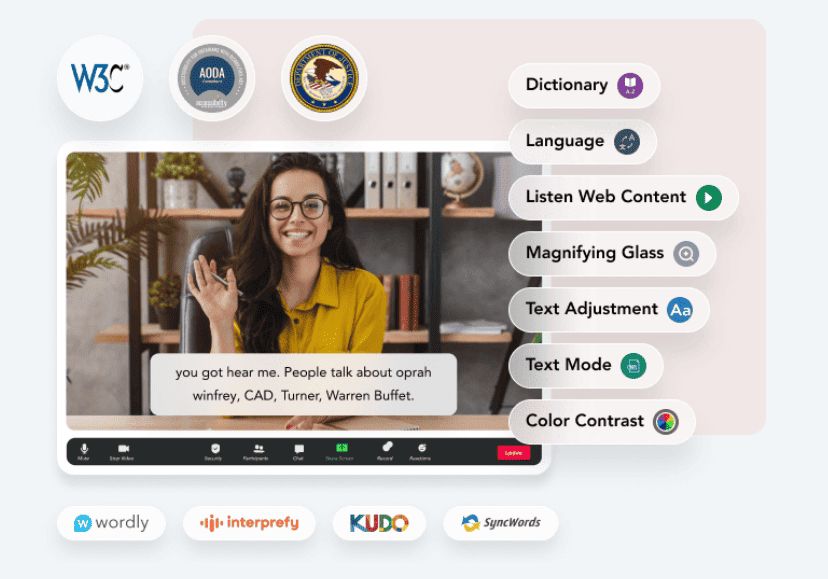
Accessibility features are additional enhancements that you can make to your event platform that allow attendees with disabilities or ailments to still be able to participate fully.
Some of the features that you can include for advanced web accessibility are:
- Screen Reader
- Text Magnifier
- Video Transcription
- Subtitles
- Multilingual Support
- Image Alt Attributes
- Keyboard Navigation
Here is a complete guide to hosting accessible events that can help you choose the right features to add to your virtual or hybrid event.
Chapter 4: Event Management Platforms
Event planning and management is much easier with an event management platform and tools to help you along the way. Most of the tasks on your event planning list will be easily doable if you choose an end-to-end event management platform.
These platforms can help you from the first day of your event planning process to the curtain call. Some will even include features for post-event debriefing to recap what went well or could be improved.
Event management platforms should be able to help organizers manage every aspect of their event. This includes event planning, setting up, marketing, monetization, and post-event feedback collection. However, there are so many different options, and choosing an event management platform that suits your needs can be the point of difference between an epic and unsuccessful event.
How to Choose an Event Management Platform
Before choosing an event management platform, there are a certain number of things that you should consider. The platform should be able to meet all your requirements and help you achieve your event goals. If you’re not sure what criteria you should look into, here are a few important considerations:
1. Evaluate the Features
When you have your event goals in mind, you need to judge if the platform you have shortlisted has all those event planning capabilities. You shouldn’t choose a platform that lacks some of the most vital features required for running a successful event. Otherwise, you may have to switch between a few different event planning tools to achieve the same result.
Some absolute must-have features for an event management platform are:
- Event registration and ticketing
- Agenda management
- Attendee management
- Marketing features
- Event analytics and reporting
- Onsite support
2. Focus on Customization Capabilities
Most events will need a customizable event management platform to help them achieve what they want. Event organizers don’t want to be stuck with a platform that isn’t capable of transforming according to their needs. There can be a huge difference between customization and configuration, and most platforms in the market only offer limited customization capabilities.
3. Consider User Friendliness
You should be prepared that not all of your attendees or staff members are going to be super tech-savvy. So, it is pertinent to choose an event management and event planning tool that is convenient and easy to use for everyone. You don’t want to end up spending half of your time conducting training sessions or demos.
4. Opt for a Mobile-Friendly Platform
In order to make your event easy to access and convenient to attend for everyone, you should consider choosing a mobile-friendly platform. This could mean adding a powerful mobile event app to your event experience or simply making sure that the sessions or other features are also accessible via a mobile browser.
5. Look for Integration Capabilities
The event management platform that you choose should be able to integrate with other popular tools and software that you already use as an event organizer. Some important integrations could include CRMs like Hubspot, ATS software like BambooHR, or email marketing tools like MailChimp, etc. Integrations can smoothen the planning process and you can directly transfer the data from the event planning software to these tools.

6. Consider the Price Point
It goes without saying that your event planning steps should always keep in mind the budget that you’re working with. Therefore, instead of spending more money on features that you don’t even need, you should always consider the option that serves the best value for your money. Most event planning platforms can customize a plan for you that suits your event goals and also fits your budget.
7. Make Customer Service a Priority
Choose an event planning platform that puts customers first and will make sure all your needs are met. Customer service is often ignored but can be the biggest point of difference for you. Whenever you’re choosing a platform, read reviews from customers on third-party and impartial websites like G2 and Capterra to make an informed decision.
8. Look for Robust Reporting Features
Event organizers can often understate the importance of event analytics and attendee data. You can get a lot of answers if you focus on what your attendees liked or disliked. Audience behavior during the event and post-event feedback data can offer quantitative and actionable insights to further improve your event. Therefore, an event management platform that offers detailed reporting and analytics should be a key priority to debrief after the event is over.
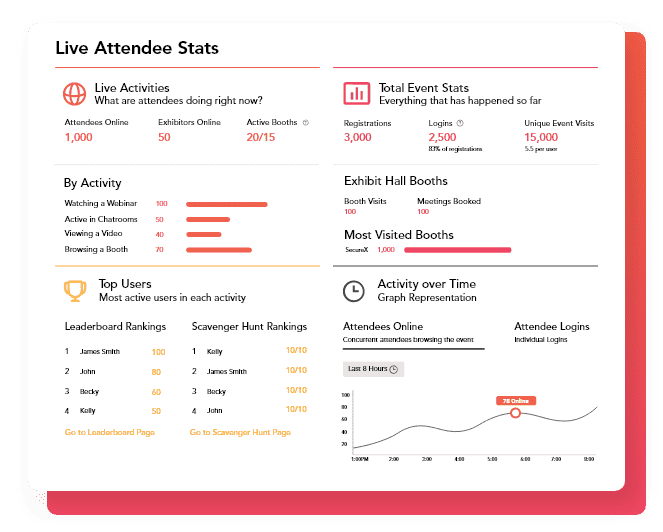
9. Leverage AI Capabilities
No software or tool is complete without additional AI-powered integrations. AI can help event organizers during most event planning steps and should be something you’re looking for. For example, vFairs offers a powerful AI Marketing Assistant that can help you write copy for marketing campaigns, social media, press releases, and landing pages within a few minutes.
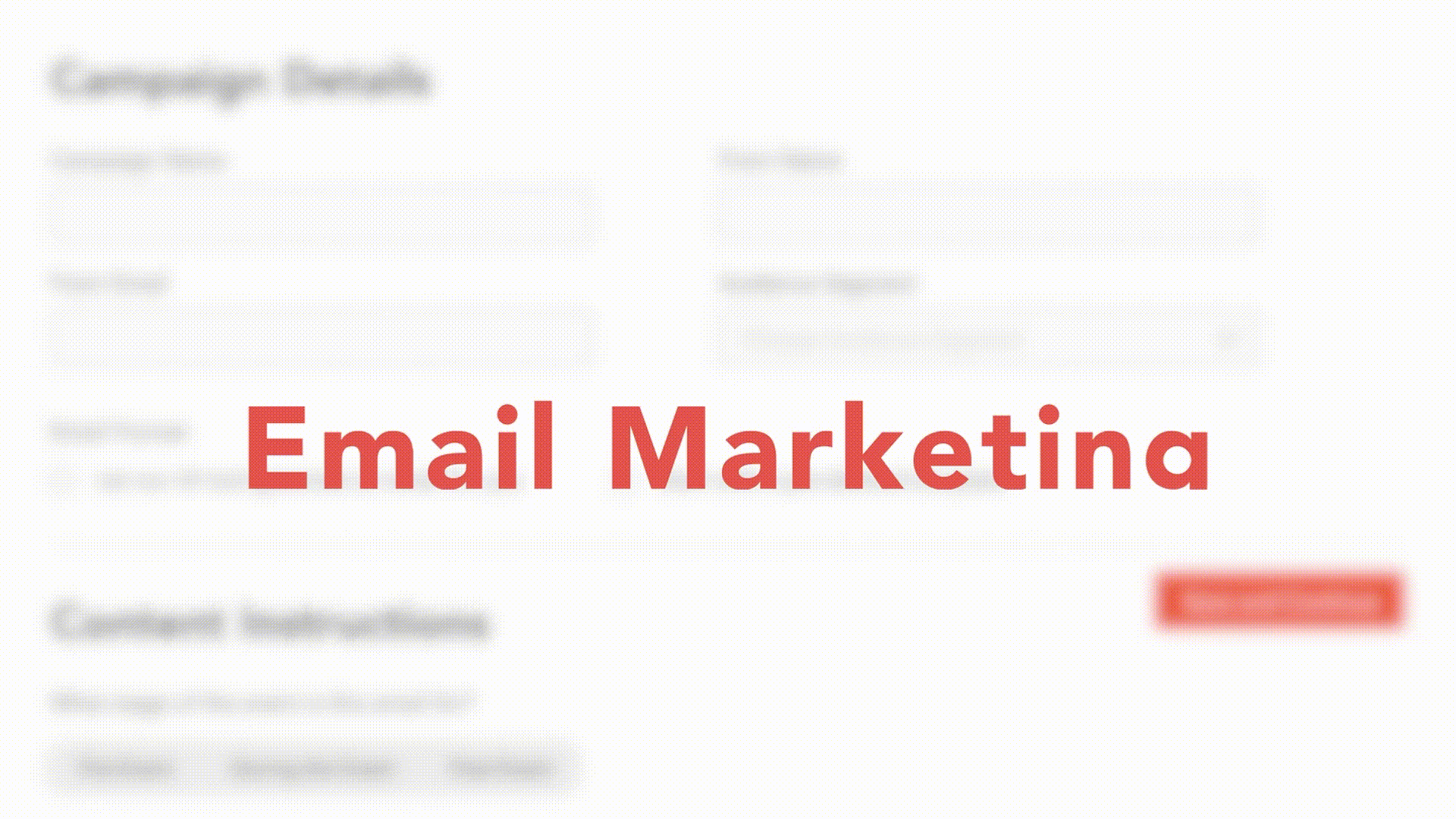
10. Monetization & Sponsorship Opportunities
Most events have an ROI or revenue goal that they want to achieve and sponsorships can be a great way to do that. Your event management and hosting platform should be able to offer ample sponsorship opportunities so you can monetize some aspects of your event. This could be the ability to create custom branding for booths or lobbies, host sponsored content, provide marketing real estate to your sponsors, etc.
11. Consider Platform Scalability
Your event could have 100 attendees or 10,000, and the platform you choose should be able to handle both scenarios seamlessly. You could be hosting events of varying sizes and the event planning and management platform should be able to scale with you without sacrificing on quality.
You can streamline event planning by choosing an event management platform that offers all-in-one features. This reduces the need to hop on to various different event planning tools or manage talks with multiple vendors simultaneously. It is your best bet as you can save time and hassle and streamline all your workflows. An all-in-one event management platform can help you direct all stakeholders to one platform and minimize the event planning chaos.
Choosing an Event Management Platform When Planning an Event
We can help you narrow down your search by naming the top event management platforms in the market along with their pros and cons. Full disclosure that this isn’t an exhaustive list and you should vet your options according to your specific needs.
Make sure to first fully understand what you are looking for in an event planning solution and only select platforms that will fulfill your event goals. Always read up on all G2 and Capterra reviews for the event management solutions you are considering.
There is a lot of information there and you can easily find the right solution for your company and event. You can inquire from peers within the industry for referrals. But most importantly, once you have shortlisted some options, book a demo to get clarity on what the solution offers.
Tip: Even if you have a clear idea of what your event goals are and what you’re looking for in an event planning platform, there can still be a bunch of options to choose from. Read our best event management platforms guide to weigh the pros and cons and choose the best option for yourself.
Chapter 5: How to Market Your Event Like a Pro
Effective event marketing is crucial if you want to get the word out about your event. You may have created the best list for easy event planning but if you don’t nail all your marketing efforts it could all go in vain. The event management platform that you choose could also help you in creating marketing campaigns that attract more attendees.
There are so many things that you can do while planning an event to boost your marketing efforts and create a buzz around your event. Here are a few important steps to take when you’re just starting out.
1. Build an Event Landing Page
One of the very first things that you need to do is to develop a landing page for your event. This is where your attendees will come to get information about your event, see the agenda, and register for it. You should make sure that the landing page speaks for your event with a brilliant design and feel because it can be the first impression for most potential attendees.
If the landing page doesn’t tell them what the event will be like, you’re likely looking at a massive bounce rate and low registrations. To build a high-converting landing page, focus on visuals as well as the page copy. Spend some time researching and creating a page that compels visitors to register.
2. Create Marketing Collateral & Distribution Channels
Now is the time to start building out your marketing armor. This includes everything from the landing page content, social media posts, event videos, press releases, etc. Creating marketing collateral was a time-taking ordeal for many event organizers. However, you can now use AI-powered marketing tools to create content in minutes.
All the marketing collateral you create will need the right distribution channels or it won’t make any difference. The ideal distribution channels for your marketing efforts can be:
- An event website
- Press release wire distribution channels
- Social media websites
- Paid ads
- Email distribution lists
- Physical distribution such as event standees, brochures, banners, etc.
- Event listing marketplaces such as vFairs Discover
- Third-party marketing websites like EventBrite, etc.
3. Find Sponsored Partnerships
Sponsorships are one of the best ways to increase event ROI, but these partnerships can also be used to get more eyes on your content. The power of marketing your event through your event sponsors and exhibitors is still untapped. You can ask them to share all of your content with their audiences to get more exposure and event engagement.
Moreover, sponsored activities at your event such as a live session or networking event can also bring in more traffic. The rule is simple: the more people talk about your event, the more chances there are of higher attendance.
So, make sure that you ask your sponsors and exhibitors to talk about your event and share as much information as they can with their personal audiences. This can amplify your reach and create higher resonance.
4. Explore Influencer Marketing
Influencers on social media can have a lot of impact on your event attendance. Influencer marketing might be one of the most hit or missed opportunities for many event organizers and therefore it isn’t their first choice of medium. However, the key is to find the right influencers for your event.
For example, if your conference is about health and wellness, you should look for influencers in that niche only. They will have the right audience to speak to and can get your event in front of eyes that are actually interested in consuming such content.
Event marketing is a massive task on its own and if you are new at this, you probably don’t know where to start. For a detailed inside scoop, you can read our event marketing guide and get all the information you need on creating the ideal marketing plan for your event.
Chapter 6: How to Monetize Your Event
Planning an event also means considering how you are going to make money out of it. Events can either be free or paid, but ticketing is not the only way to monetize your event. There are a lot of other ways to make money as an event planner, and this event planning guide will help you set up some of them.
1. Get Sponsors On Board
Event sponsorships can boost revenue for any event and finding the right ones should be a part of your event planning process. Event organizers can create various tiers for event sponsorship packages and offer special discounts and services to organizations that fill up these sponsorship spaces.
Each tier can have a different level of added advantages and pricing options. So, the more a sponsor pitches in, the additional eyes they can get for their brand.
If you aren’t sure what to add to your sponsorship offers, here are some ideas you can use.
In a virtual event, fully customizable lobby designs can ensure that sponsors have enough real estate in the venue. You can do the same for physical venues by setting up standees, banners, posters, etc.
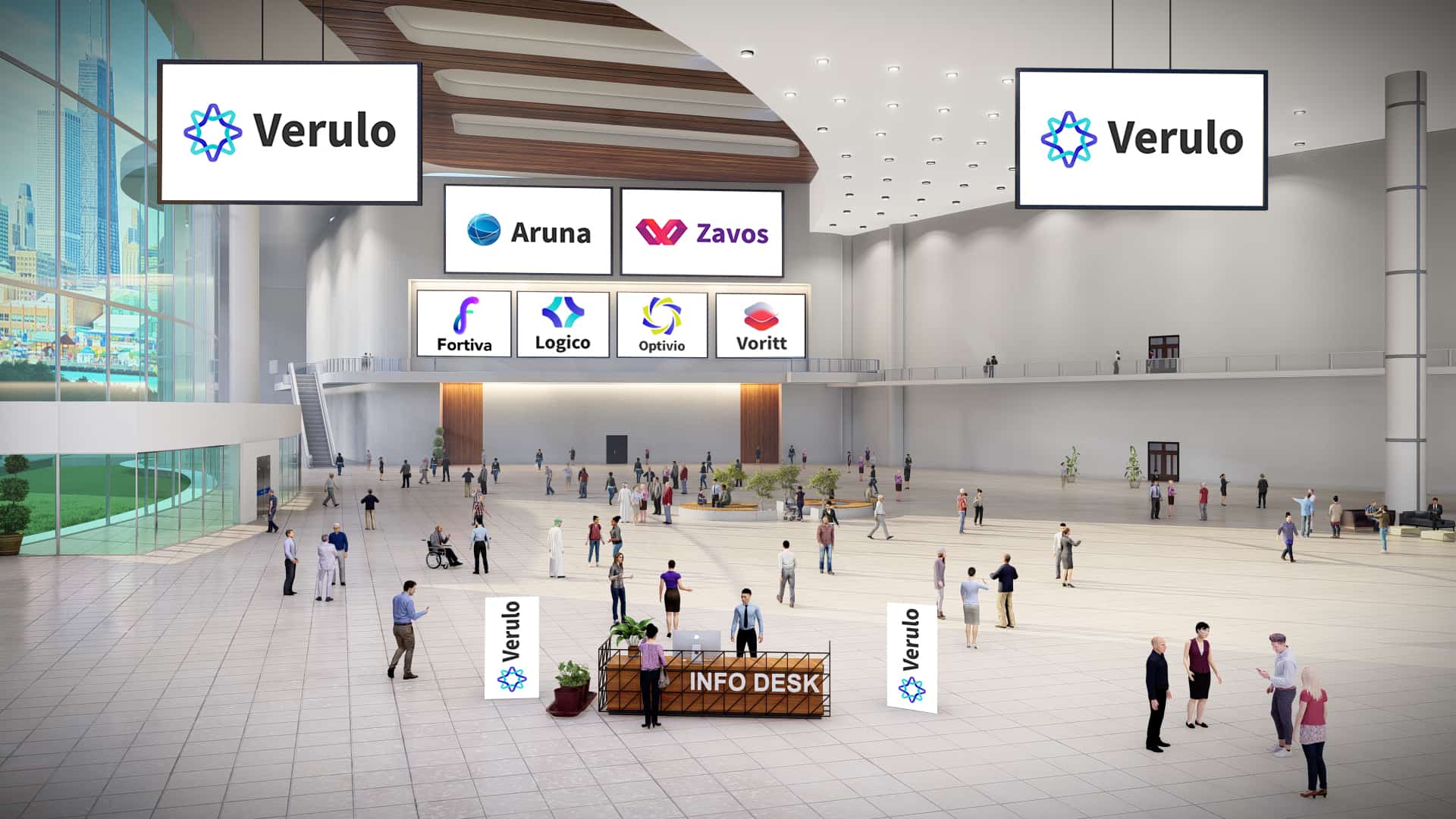
Printed material like attendee badges can have sponsor logos.

You can also offer sponsored activities within the event. For example, a scavenger hunt or a webinar.
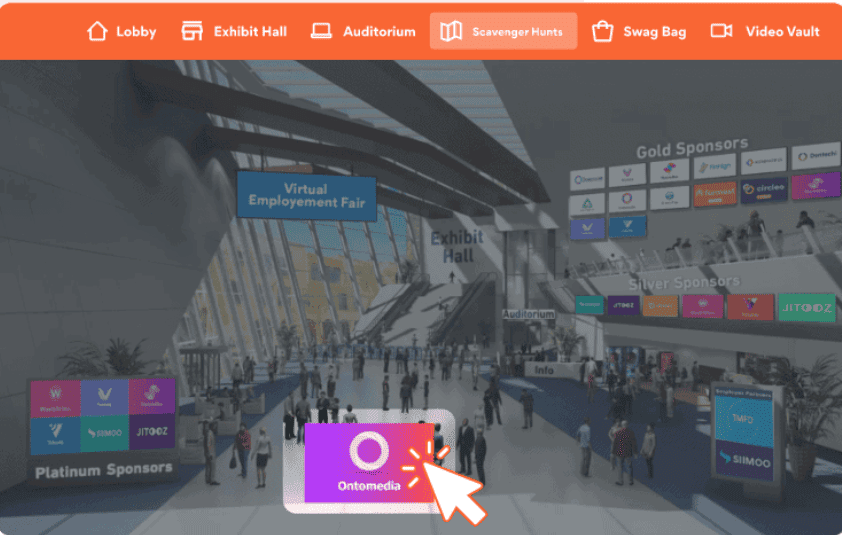
Sponsors can set up a branded booth at your event for free to connect with attendees and generate leads.
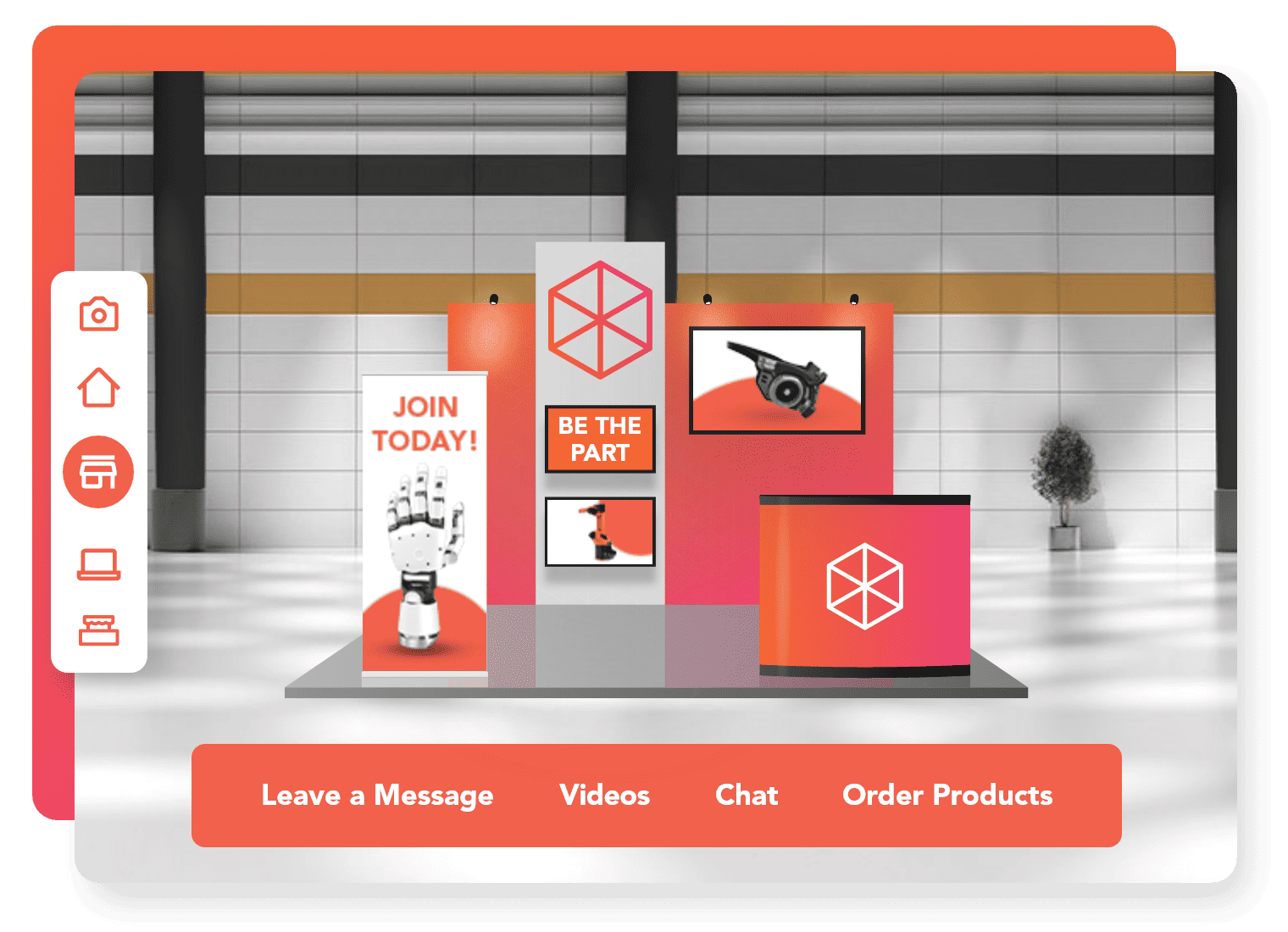
They can also get a certain number of free tickets to the event.
You can consider offering sponsors services or discounts from your organization that they can avail after the event is over.
2. Gather Exhibitors
Exhibitions can work at pretty much any type of event whether you are planning for it or not. Adding a virtual exhibit hall to your event isn’t a problem at all as online event platforms like vFairs are fully customizable and accommodate as many halls as you like. This requirement is also something to consider during event planning as you can’t add another hall at the eleventh hour. However, if you’re hosting a hybrid or in-person event, you may need to choose a venue that has additional space for an exhibition.
It can be an investment for a better ROI for your event as each exhibitor needs to pay for a space at your event. The more buzz you create, the more exhibitors will be lining up outside your gates for a chance to showcase their products and services. You can use attendee numbers and quantifiable past engagement levels to create a level of FOMO for exhibitors at your event.
Exhibition space is only the primary charge. The bigger the space, the more you can charge for it. Moreover, any additional customizations are also ground for more charges for each exhibitor booth. At physical venues, you can also rent out extra tables and chairs or standees to your exhibitors.
3. Tiered Ticketing
Asking registrants to pay for tickets might be the most obvious way to make money at an event. However, if you are planning an event that you want to make more accessible for all, things can get tricky. This is where tiered pricing can come into play.
You can still have a free or nominal charge pass that most attendees will use to get into your event. However, tiered pricing allows you to charge more from potential customers that are willing to pay a premium for added services. More expensive tickets can include a better seat, a meal box, refreshments, parking space, bonus content, accommodation, etc.
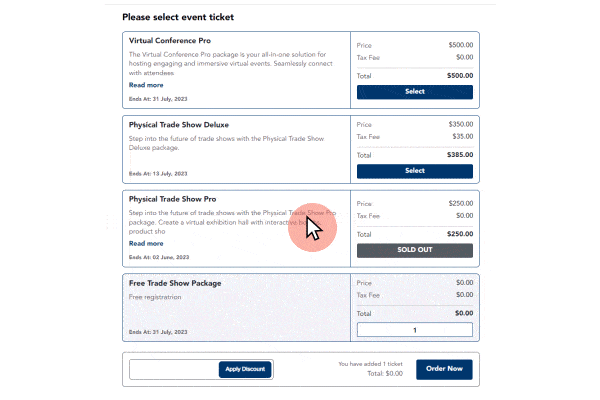
4. Sell a Full Access Pass
Apart from the tiered plans for ticketing, some events also sell a full-access pass. This can include even further VIP treatment that only a select few attendees can get their hands on. During the event planning process, think of the features that you want to make exclusive for all-access pass holders. This can be a great idea for events that have a celebrity pull. You can think of it as a backstage pass to a concert. You can sell a full access pass to entice attendees into paying a premium for a chance to get to meet those celebrities.
5. Sell Advertising Space on Your Venue
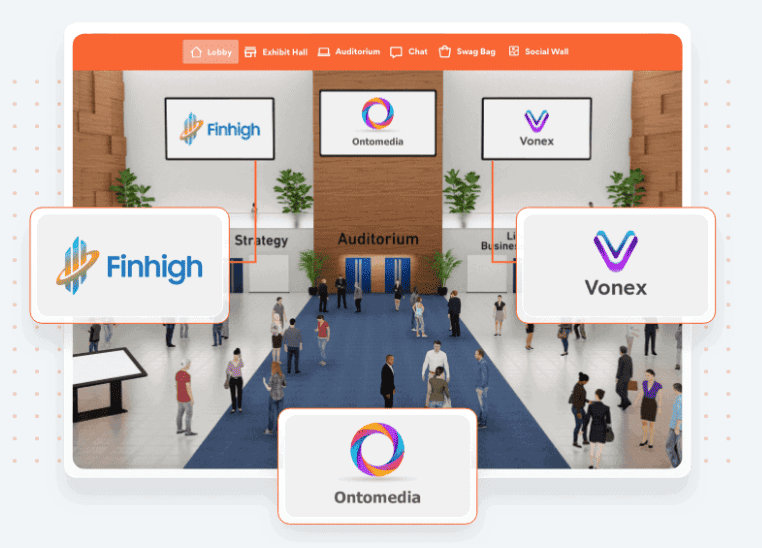
Advertisers are always on the lookout for more space to run their ads. Whether you are hosting an in-person event or are completely online, you can offer ad space to companies and advertising agencies. If your attendees are their target audience, it is a win-win situation for everyone involved. You need to create real estate and potential high-traffic places in your event for ad spaces during event planning.
You can get in touch with advertising agencies and set up plans for them to rent out ad space. However, you also need to be sparing with ads as they can completely ruin the event experience for your attendees. So, the ad space is under your control and can be as small as one standee or brochure, or as big as a billboard. Make sure to brainstorm creative ways to place ads during event planning so they don’t end up staring attendees in their faces.
Chapter 7: Tips for Successful & Easy Event Planning
Event planning can be a tough nut to crack even if you create a thousand checklists. You have to stay organized almost all the time and human beings are bound to make mistakes. So, instead of fretting about all the tasks that you need to complete, you have to develop a game plan and then stick to it. You can deal with any eleventh-hour changes too if you have contingency plans and Plan Bs to fall back on.
Event Planning Tips for Virtual Events
Create an Event Planning Worksheet
Your event planning worksheet needs to include everything from day one to the final curtain call. One of the most difficult things when planning an event solely for online audiences is that you don’t get to see a physical impact. This can make it harder to visualize the attendee’s perspective and you may lose your focus sometimes. That is why, an event checklist template and a proper event planning sheet can help you stay on track and make sure you design an event that will be memorable for all attendees.
Focus on Creating Immersive Experiences
Virtual events and online activities can be a hit or a miss if event organizers haven’t fully considered the attendee experience. You need to make sure that you focus on creating experiences that attendees will remember and fully engage with the event. During event planning, talk to your team and brainstorm ideas for engaging your attendees during the event. This can include more networking opportunities, quizzes, and other gamification features to keep everyone fully invested.
Leave The Pandemic Behind
Event planning and management was a big fat mess during the pandemic and it was one of the biggest reasons for virtual events becoming as big as they are right now. While the pandemic is long gone, people still seem to be interested in attending online events.
Event organizers also need to move past the woes of the pandemic and think of virtual events as an option rather than the only possible one. There are many features that you can add at a virtual event that transcend the pandemic and organizers can help attendees see and use them to their advantage.
Listen to the Audience
It can be difficult to connect with your audience through the virtual platform, however, that can be key to planning a successful event. You can keep an eye on the most viewed webinars, or the most visited booths to make sure what your attendees are most interested in. Moreover, you should add feedback collection mediums like webinar ratings, feedback surveys, etc.
Event Planning Tips for In-Person Events
Be Prepared for the Worst
You are hoping for the best possible scenario due to rigorous event planning efforts, but you also need to make sure you are prepared for the worst. This is true for all types of events, but handling a problem at an in-person event might be the most complicated. Therefore, it is important to always have a plan B and think of every possible solution well in the early stages of event planning. Thinking on your feet and improvising are important to transform a complete disaster into a minor hiccup.
Get the Right Venue
Venue sourcing is one of the most important aspects of in-person event planning. You should take your time in selecting the right venue and considering every possible aspect. The location, the spaciousness you require, the number of rooms and parking spots, and the price point are some of the most important factors to consider when choosing a venue.
Leverage In-Person Event Technology
The world has changed how it hosts events and in-person event technology is what has brought forward that revolution. If you are planning an event, you should look into all the innovative new technologies that you can incorporate into it. Things like an easy badge scanning app at the check-in counter or an event mobile app can greatly improve the attendee experience. Moreover, relying on technology can also reduce some of the workload from your staff and streamline event planning.
Event Planning Tips for Hybrid Events
Bring All Audiences Together
One of the biggest challenges for event planning and hosting with in-person and online attendees is bridging the gap between them. You need to make sure that both audiences feel a part of the same event and have similar experiences.
You should add networking features that both audiences can participate in and connect with each other. Gamification that is open for both in-person and online attendees can also create a more harmonized experience.
Integrate Your Event Tech Stack
Hybrid events can already be difficult to juggle as you need to focus on both online and in-person aspects of event planning. Therefore, it is important to integrate the tech stack that you are already using into your event management platform. This can include ATS, CRM, or marketing tools so that each step of the event planning and managing process runs smoothly.
Chapter 8: Post-Event Tips for Event Organizers
Most event organizers would assume that their event planning jobs are done when the event is over. But this might be a big mistake!
Post-event analytics and debriefing are a big miss if you skip doing this immediately after the event. The feedback and experience will still be fresh and you can draw much better conclusions from them. Here are a few great tips to catch up on post-event activities and plan accordingly.
1. Gather Attendee Feedback
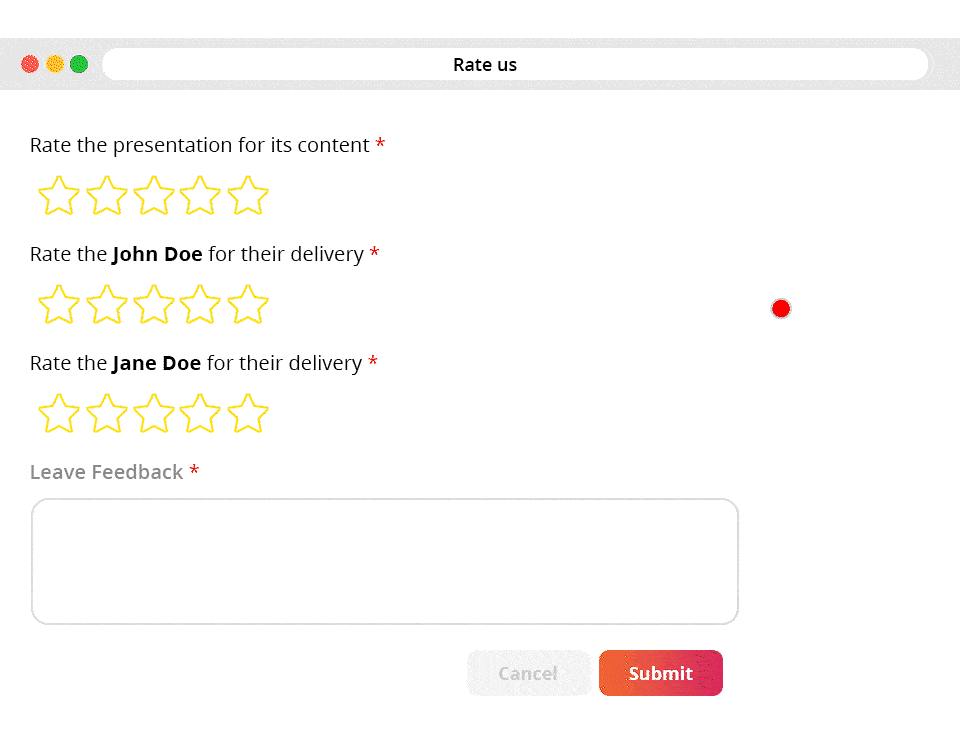
Collecting feedback from attendees when the event is underway can help you make some quick fixes on your toes. However, collecting post-event feedback might be a much more important part of event planning and management. This can give you much more detailed insights into how the experience was for each attendee and what they liked or disliked about the event.
So, make sure that you make post-event polls and feedback surveys a part of your event planning checklist. It can be easier to miss out on these if you haven’t planned in advance.
2. Dig Deeper into Event Analytics
Live event analytics offer a lot of actionable insights and can be used for team meetings that happen post-event. These can set the groundwork for you and your team when you’re planning an event next time. The more you analyze these analytics, the deeper understanding you can develop for your attendees.
So, when you’re in the event planning process for upcoming events, you have all these insights that you can use to set it up. No one can understand your audience better than you, and the only way to successfully achieve that is through a data-driven approach. Pick and choose what you want to include and exclude for an even better experience for your next event.
3. Build a Lasting Community
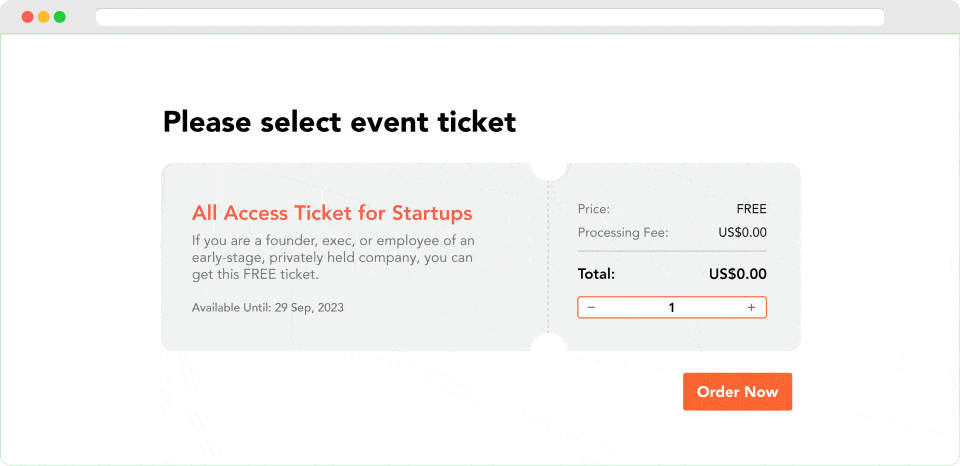
If event planning and hosting is something you do often, it is important to build a community around them. This can include prospective new attendees, current stakeholders, speakers, sponsors, or event professionals. When someone leaves your event without following your social media accounts or developing a connection with one of the event organizers, you might have lost a lead.
Therefore, make sure you develop a deeper and more personal connection with each of your attendees and welcome them into a bigger community to connect. Hold on to your attendees! You can ask them to join a Facebook group, drop their business cards with you, or simply follow your event page for future updates.
Leverage Event Planning & Management Platforms to Execute Epic Events
You aren’t the only one struggling with how to plan an event and execute it to perfection. Event planning is a big take on and you need to be organized at all times, every step of the way. We’ve answered some pressing concerns about how to plan an event and how to leverage event tech. Here’s a quick recap of everything we discussed:
- Make use of this event planning guide and our event planner template to get started. To ensure your event planning and execution is a breeze opt for an all-in-one event management platform.
- Streamline ticketing and registration for onsite and virtual attendees. Offer an event dashboard to manage every aspect of your event and use a mobile app to expedite processes like check-in and navigating through an event.
- Most importantly, make sure you choose a platform that offers stellar customer support to help you through every step of the way.
If you’re curious to see how an event management solution works, book a demo with us.
FAQs
What is event planning?
Event planning and event management is the complete process of managing, marketing, and executing a virtual, in-person, or hybrid event.
What are the steps in event planning?
Event planning consists of the following steps:
1. Create an event goal.
2. Build a team.
3. Curate the right agenda for your event.
4. Gather sponsorships, speakers, and exhibitors for your event.
5. Start building the event by curating a venue and choosing a date.
6. Market your event through social media and other mediums.
7. Manage all the logistics of the event on the event day.
8. Debrief with post-event analytics.
How do you get started with vFairs event management software?
You can book a meeting and detailed product demo with us by filling out the form on our website or getting in touch at sales@vfairs.com for more information.
Is there a free trial for vFairs event management platform?
No, vFairs doesn’t offer a free trial, however, you can book a demo with us to get a detailed look into what vFairs can do to support your event planning needs.


